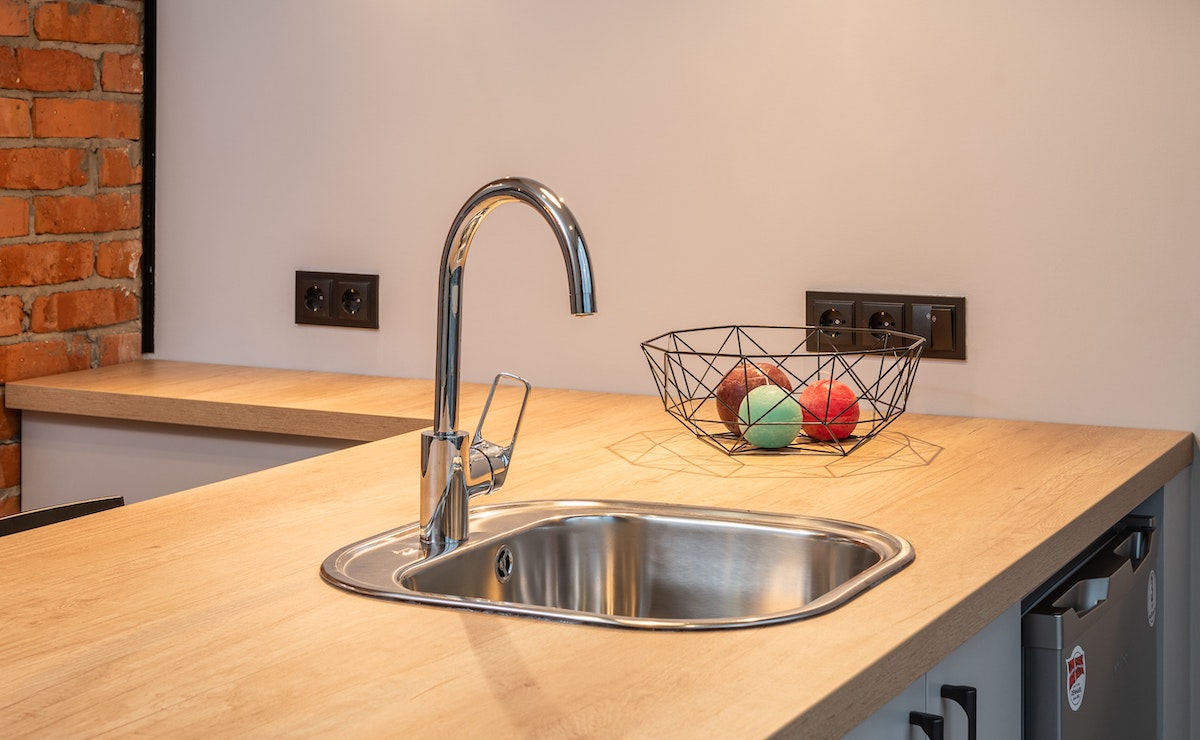What Is A Monobloc Kitchen Tap?

When it comes to the humble kitchen tap, functionality and aesthetics are both important to consider.
You need something practical and hard-wearing, yet also attractive enough to suit your kitchen's style.
With various types of taps available, choosing the right one for your needs can be a bit of a task.
One style that's garnered significant attention over the years is the monobloc kitchen tap.
But what exactly is it?
In this blog post, we're going to explore the ins and outs of monobloc kitchen taps, their features, advantages, and why they might just be the perfect addition to your kitchen.
Click here to see our complete range of kitchen 1810 sinks...
What Is A Monobloc Kitchen Tap?
A monobloc kitchen tap refers to a tap with a single stem or body that houses both the hot and cold water controls.
The term 'monobloc' literally means 'one block', hinting at the single-unit design of these taps.
Despite the shared body, the hot and cold water supplies remain separate within the tap until they're mixed when the tap is turned on, ensuring you can adjust the temperature to your preference.
Monobloc taps can come with a single lever that controls both the temperature and flow rate, or they may have two separate handles for each.
The streamlined, compact design of these taps makes them a popular choice for modern and contemporary kitchens.
Their ease of use and minimalistic style are appreciated by many homeowners and interior designers.
However, it's important to note that to install a monobloc tap, your sink or worktop needs to have a single hole, as opposed to traditional taps that require two separate holes for the hot and cold taps.
This is something to bear in mind when considering a kitchen renovation or a tap upgrade.
(Click this page to see out complete range of kitchen sinks online).
What Are the Advantages of Monobloc Kitchen Taps?
Monobloc kitchen taps have become increasingly popular due to a variety of benefits they offer:
- Streamlined Design: The monobloc tap's single-unit design gives it a sleek, modern look that suits contemporary kitchen styles. Its minimalistic profile makes it a neat and tidy choice for any kitchen.
- Ease of Use: Many monobloc taps come with a single lever control, which makes adjusting water flow and temperature a breeze. This can be particularly useful for people with limited hand mobility, or when you have your hands full in the kitchen.
- Versatile Styles: Monobloc taps come in a wide range of styles and finishes, such as chrome, brushed steel, brass, and even coloured options, so you're sure to find something that fits your kitchen's aesthetic.
- Space Saving: The compact design of monobloc taps requires only a single hole in your sink or worktop, saving space and giving a clean, uncluttered look. This is particularly beneficial in smaller kitchens or where countertop space is at a premium.
- Easier Maintenance: As they are a single unit, monobloc taps often have fewer parts that can go wrong or leak, making them typically easier to maintain or repair.
- Compatibility: They're also suitable for both low and high-pressure water systems, making them a versatile choice for different home setups.
However, like any other product, they do have their considerations.
For example, if your sink or worktop has already been drilled for separate hot and cold taps, adapting it for a monobloc tap could be a significant job.
But overall, their benefits make them an attractive option for any kitchen.
What Are the Disadvantages of Monobloc Kitchen Taps?
Despite their many benefits, monobloc kitchen taps do come with a few potential drawbacks that you should consider:
- Installation Limitations: If you're replacing traditional separate hot and cold taps with a monobloc tap, you may need to adapt your sink or worktop, as monobloc taps require a single hole for installation. This could mean extra work and cost.
- Potential for Temperature Fluctuation: In some monobloc designs, particularly those with a single lever, it can be a bit tricky to get the exact water temperature you want. You may need to adjust the lever a few times to find the perfect balance between hot and cold.
- Limited Style Options for Traditional Kitchens: While monobloc taps do come in a range of designs and finishes, their inherently modern look might not be the best fit for a kitchen with a more traditional or vintage style.
- Cost: Monobloc taps can sometimes be more expensive than standard separate taps, depending on the design and brand.
- Higher Pressure Needed: Some models of monobloc taps may not work as efficiently on low water pressure systems, so you'll need to check the manufacturer's specifications to ensure compatibility.
While these factors could influence your decision, it's worth remembering that many homeowners find the benefits of monobloc taps outweigh these potential downsides.
As always, it's important to consider your specific needs, your kitchen's design, and your budget when choosing the right tap for your kitchen.
(Click here to see our complete range of kitchen taps for sale online).
What is the Difference Between a Monobloc and a Mixer Tap?
The terms 'monobloc' and 'mixer' are often used interchangeably when it comes to kitchen taps, but they do have slightly different meanings.
Both types of taps mix hot and cold water, allowing you to achieve the desired temperature.
However, the main distinction lies in their design and installation.
A monobloc tap is named for its single-body design.
It has one hole for installation and can have one or two handles or levers.
The water flow and temperature are controlled either by a single lever or by two separate handles for hot and cold water, which are located on the body of the tap itself.
This design is favoured for its sleek, modern appearance and its space-saving attributes.
A mixer tap, on the other hand, is a broader term that can refer to any tap that mixes hot and cold water, regardless of its design.
While a monobloc tap is technically a type of mixer tap, not all mixer taps are monobloc.
Some mixer taps have two separate valves for hot and cold water and require two holes for installation, one for the hot valve and one for the cold.
These valves are often connected by a bridge, which is where the hot and cold water mix.
So in essence, while all monobloc taps are mixer taps, not all mixer taps are monobloc.
Your choice between the two would likely come down to the look you want for your kitchen and the practicalities of installation.
Tips From an Expert Kitchen Fitter
Over my many years of working as a professional kitchen fitter (and also the owner of a kitchen manufacturing company), I have sold and installed thousands of monobloc tap units.
I have also had monobloc units in more than one of my own family kitchens.
I think they are great and unless you want a really traditional look for your kitchen sink I think monobloc are a great option.
Final Notes On Monobloc Kitchen Taps
Monobloc kitchen taps, a type of mixer tap defined by a single body design, have become increasingly popular for their sleek look, user-friendliness, and compatibility with different water pressure systems.
Their compact, space-saving design is especially advantageous for smaller kitchens or for those who prefer a tidy, uncluttered look.
However, like any other product, monobloc taps are not without their considerations.
They might not suit every kitchen style, specifically more traditional ones, and might require significant modifications if you're replacing separate hot and cold taps.
Also, precise control of water temperature can sometimes be a bit challenging with certain models.
Despite these potential downsides, the myriad benefits offered by monobloc taps make them an appealing choice for many homeowners.
When choosing the right tap for your kitchen, remember to consider your specific needs, the existing design of your kitchen, and your available budget.
After all, the perfect kitchen tap is the one that works best for you in terms of both function and form.
With a bit of patience and the right steps, you can ensure the smooth and efficient running of your kitchen tap.
More Great Advice From the JMT Trade Kitchen Blog
- How to Unblock a Kitchen Sink Step-by-Step
- How to Fit a Kitchen Sink Step-by-Step
- How to Clean a Kitchen Sink Drain Step-by-Step
- Why Does Your Kitchen Sink Drain Smell Bad?
- Why is There a Leak Under Kitchen Sink When the Water is Turned Off?
- What is the Best Material for a Kitchen Sink?
- How to Remove a Smell From a Kitchen Sink?
- What Size of Box Spanner Do You Need for a Kitchen Tap?
- Why Does My Kitchen Tap Drip?


